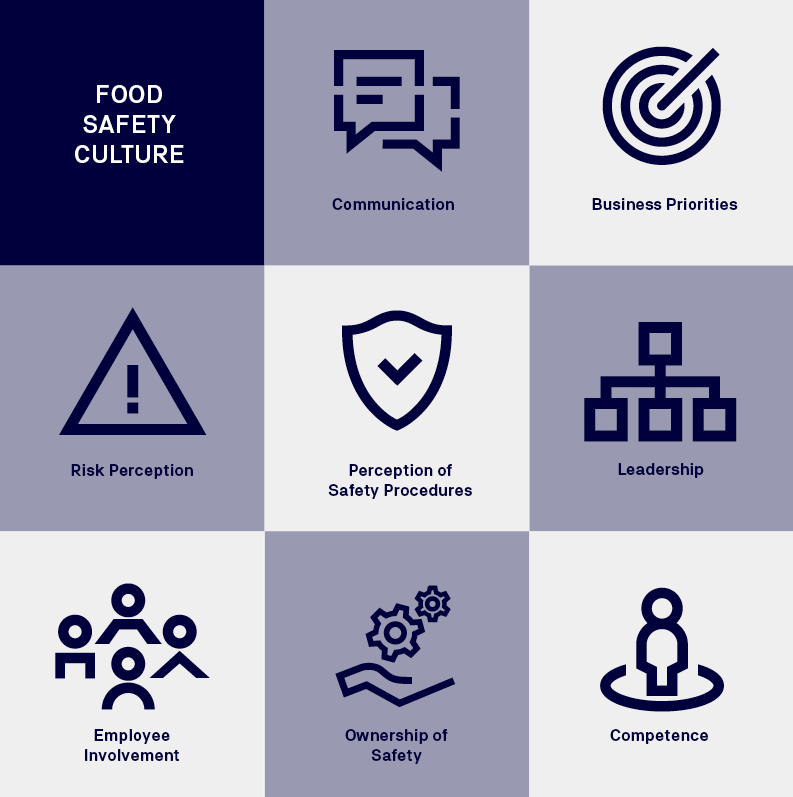Food safety culture as a central element for food safety
A practised food safety culture makes the company less vulnerable to incidents that could cause food contamination. The awareness that only the implementation of a corresponding safety culture in food processing companies offers sustainable protection has now also gained acceptance at the highest political level. The EU Commission has revised Regulation 852 as the legal basis for food safety in the EU.
Food safety culture has thus arrived at the centre of hygiene requirements. Already in February 2020, the Global Food Safety Initiative (GFSI) updated its benchmarking criteria. You can find all the information on the benchmark for you here. The EU has now followed suit and enshrined the food safety culture in law. The new requirements are set out in EU Regulation 2021/382, which amends the Annexes to Regulation (EC) No 852/2004.
Essential for the implementation of the food safety culture in the company is the comprehensive training of employees with regard to hygiene, HACCP and other regulations, which are a prerequisite for the implementation of the food safety culture.




What is Food Safety Culture?
The GFSI Technical Working Group defines food safety culture as "shared values, beliefs and norms that influence food safety attitudes and behaviour within, across and throughout an organisation".
The BRCGS definition is "The attitudes, values and or beliefs which are prevalent at the site, relating to the importance of product safety and the confidence in the product safety systems, processes and procedures used by the site".
The IFS describes food safety culture in more detail:
Shared values, beliefs and standards that influence attitudes and behaviour towards food safety in an organisation, across all areas and throughout the organisation. Elements of food safety culture are the elements of food safety management that an organisation's management can use to promote a food safety culture within the organisation.
At a minimum, these should include:
- Communication about food safety policies and responsibilities.
- Training
- Feedback from employees on food safety issues
- Performance measurements
We answer exactly what this means for you in the frequently asked questions about food safety culture below.
Explanatory Video on Food Safety Culture
Sorry, this video can not be played because of your privacy setting.
You can change your settings here anytime.
FAQs on Food Safety Culture
Who requires a Food Safety Culture?
The introduction of food safety culture requirements at the EU level results from the Codex Alimentarius. This sets food standards that serve as a reference for international food trade. It is based on the decisions of the Codex Alimentarius Commission, a joint body of the Food and Agriculture Organization (FAO) and the World Health Organization (WHO) of the United Nations. All EU member states are members of the Codex Alimentarius Commission and, since 2003, the European Union itself. In its global standard for general principles of food hygiene (CXC 1-1969), the Codex Alimentarius Commission introduced the concept of food safety culture as a general principle as early as 2020
The three objectives of Codex Alimentarius are:
- protect consumers and their health
- Ensure fair practices in international food trade
- coordinate the work of international governmental and non-governmental organizations in the area of food standards
Why is a Food Safety Culture important?
The existence of a Food Safety Culture means that all employees of a company know that food safety is important and necessary to be successful in the company. The Food Safety Culture has a significant influence on the behavior of employees and helps to ensure that they behave appropriately. Food safety is thus an integral part of the corporate culture.
Because cultural standards do not follow formal rules and straight lines, are often communicated through casual conversations and reinforced through thoughts and actions, they affect us unconsciously. However, it is possible to influence through the unconscious: BRCGS surveys show that companies that completed the Food Safety Culture Excellence Module reported being able to reduce the risk of incidents by 84%. Consequently, creating a food safety culture is an important task for technical management.
How to introduce a Culture of Food Safety in the company?
Compared to standards and laws, a food safety culture is not easy to implement. It is a spontaneous and instinctive development that manifests itself in rituals, work climate and core values.
To stimulate something so elusive, it is necessary to first analyze the current status of food safety culture. The BRCGS Food Safety Culture Excellence Module can assist in this process. It is the result of more than 19 years of academic research and industry experience and is based on a system that addresses four dimensions of food safety culture: People, Process, Purpose and Proactivity. An anonymous online survey maps the current status of food safety culture and results in a report that reflects the state of the various dimensions of food safety culture. It also includes general recommendations on how to improve the food safety culture. Get all the information on the BRCGS Food Safety Culture Excellence Module here. [Link to article on BRCGS Food Safety Culture Excellence Guide.]
The GFSI has published a position paper on food safety culture that addresses three main issues:
- The essential role of leaders within an organization (a point that is also important in the revision of ISO 9001: 2015).
- Factors such as communication, education, collaboration and personal responsibility
- Skills such as adaptability or risk awareness to translate food safety practices from theory to practice Access the position paper summary here. The full GFSI document, "A Culture of Food Safety," is available for download here.
What are goals of Food Safety Culture?
The main objective of the lived Food Safety Culture is to create the framework so that food can be produced safely and does not pose a risk to consumers. The food safety culture is communicated to the employees in the company through training, information and the focus and example of the leadership. Processes, courses of action and values are supplemented by the topic of food safety. The Food Safety Culture thus also aims to have attentive and satisfied employees in the company who can identify with their employer, pay a high degree of attention to the safety and quality of production and also motivate other employees to follow suit.
BRCGS Food is the first GFSI-certified standard to include food safety culture requirements. Other standards are following.
In particular, in GFSI recognized standards, the inclusion of food safety culture will soon be the norm, as the Global Food Safety Initiative (GFSI) has already published this in its 2020 benchmarking requirements. You can find the GFSI benchmarking requirements here. One of the most important elements of the upcoming revision is the introduction of food safety culture requirements.
What are the benefits of a Food Safety Culture?
The goal of a food safety culture is to improve employee awareness and behavior regarding food safety. A corporate culture that values food safety demonstrates directly and indirectly to employees that food safety is important and necessary to be successful in the company. This influences employee behavior and helps ensure that they behave appropriately.
For more information on what a food safety culture is and how to evaluate and promote it, please see the official GFSI documents on our website, or click here to read that BRCGS Food Version 8 is the first GFSI-certified standard to include requirements for a food safety culture.
How to develop the Food Safety Culture?
1. strengthen Shared Values, Beliefs and Norms.
Any culture requires the existence of groups that share values with new members of the group and make them liveable through appropriate behaviors. It takes a lot of time to translate norms and guidelines into daily practice and to anchor them as self-evident and shared by all. Practiced rules of culture are in many cases unwritten and sometimes unspoken. This is one of several reasons why culture is perceived as difficult to change. A change in the formal system, does not immediately change the perceptions and behaviors of the people affected. If available, you can build on your existing food safety management system and establish or expand a food safety culture.
2. Clarify what drives employee thinking and behavior.
Our beliefs, mindsets and behaviors are influenced by many factors. These include the culture of the country in which one lives, the individual's upbringing and biography, the work environment and past practices in the workplace. And, of course, our department, colleagues, role and function, job security, habits, and our level of knowledge and self-image in relation to our tasks also influence us.
When trying to establish and also maintain and develop a food safety culture, it is important to consider the overall values and mission of the company. This is because the thinking of individuals is influenced by these. For example, are individuals' functions, roles and expectations clearly defined and were they involved in defining those roles? Do they understand how their roles contribute to the organization's mission or purpose? What is the leadership's commitment to food safety by example? They are essential to the food safety culture of any organization.
3. Change the culture of the organization over time.
To realize a food safety culture, food safety must be defined throughout the organization for each member and department in terms and expected behaviors that are relevant and clear to them. For example, what is required of purchasing is different from what is required of maintenance. Purchasing should understand the importance of selecting suppliers that are both economically viable and meet the company's food safety requirements, not one or the other. Similarly, a maintenance manager should pay attention to the condition of equipment to maximize uptime as well as food safety. For smaller companies, the owner/operator leads by example and significantly influences the food safety culture. A mature food safety culture is one in which the company vision and mission has been broken down to the smallest details of expectations for each department and person throughout the company.
Further information for you
We will take you further
As an internationally accredited certification company, TÜV NORD has comprehensive expertise. Our auditors have in-depth industry knowledge and an interdisciplinary mindset, and undergo annual, intensive training programs to keep your qualifications up to date. We also offer you the option of combining certifications. In addition, we offer comprehensive information and contacts for your further development. Feel free to contact us and sign up for our food safety certification information service.

Sales Certification Food, Feed and Near Food
Böttcherstraße 11, 33609 Bielefeld
Tel.: 0521 786-327
Fax: 0521 786-157
foodcert@tuev-nord.de





